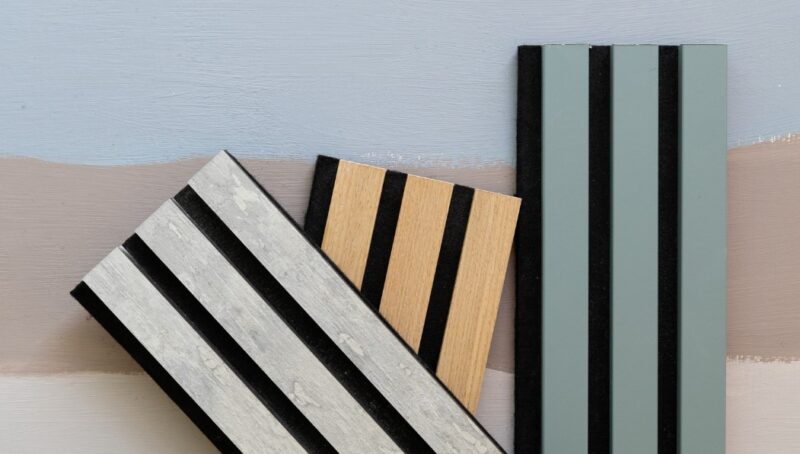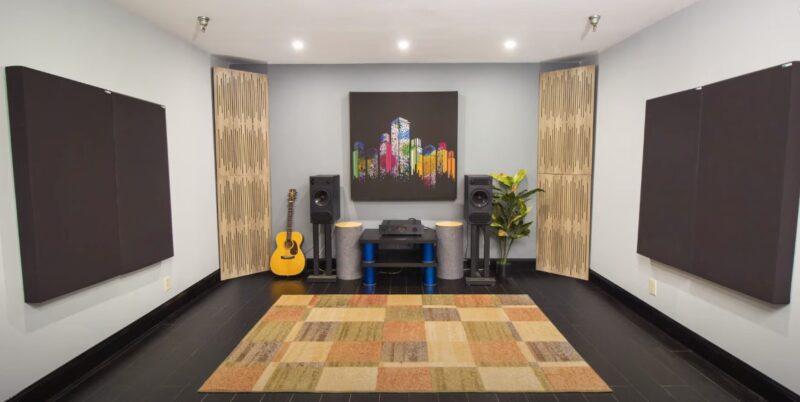Creating the perfect acoustic environment in your space is much like solving a complex puzzle. Each piece, representing an acoustic panel, plays a crucial role in harmonizing sound.
With a keen understanding of reflection points, absorption coefficients, and the unique acoustic needs of different spaces, you can elevate your home office, living room, or any room to an auditory haven. It’s a journey where science meets aesthetics, and the destination is clear, crisp sound.
What is the Best Solution?

The quest for the best acoustic treatment solution is not a one-size-fits-all endeavor. Various factors such as room size, shape, purpose, and even budget play a pivotal role in determining the most effective approach.
Wall-Mounted Acoustic Panels
Wall-mounted panels are the go-to solution for most spaces. They effectively reduce noise levels and eliminate echoes. For instance, placing panels at first reflection points (the spots where sound directly bounces off to the listener) dramatically improves sound clarity. In a rectangular room, these points are usually found on the walls, parallel to the speakers.
Ceiling-Mounted Panels
Ceiling-mounted panels are indispensable in rooms with high ceilings or where floor-to-ceiling slap echo is an issue. They help reduce vertical reflections and can also address issues like Speaker Boundary Interference Response (SBIR), improving overall sound quality.
Floor Solutions
While placing acoustic panels on the floor is less common, using floor stands or rugs can be beneficial, especially in rooms with hard flooring. These elements can help minimize floor reflections, contributing to a more controlled sound environment.
Free-Standing and Removable Panels
For flexible or temporary solutions, free-standing or removable panels are ideal. They are perfect for renters or in spaces where permanent installation is not possible. These panels can be strategically placed as needed and easily removed or repositioned.
Material and Absorption Coefficients
The material of the acoustic panel plays a crucial role. Fabrics, foam, and fiberglass have different absorption coefficients and react differently to various sound frequencies. For instance, thick, dense materials are better for absorbing low frequencies.
Symmetry and Coverage

A symmetrical approach to panel placement often yields the best results, especially in stereo sound setups. However, over-covering a room can lead to an unnaturally dead space. Striking the right balance is key.
Specialized Panels for Specific Needs
For unique needs, like soundproofing a bedroom for privacy, specialized panels designed for high noise reduction can be used. These panels not only improve the room’s acoustics but also block external noise.
Sustainable Options
For the environmentally conscious, brands like Andor Willow offer sustainable solutions. Their commitment to planting trees for every panel sold adds an eco-friendly dimension to your acoustic treatment.
Does It Require Advanced Skills?

The installation of acoustic panels often raises questions about the level of expertise required. Is this a DIY project, or should you call in the professionals? The answer depends on several factors, including the complexity of your acoustic needs and the specific characteristics of your space.
Basic Understanding of Acoustics
At its core, installing acoustic panels does not require advanced technical skills, but a basic understanding of acoustics is beneficial. This includes knowing how sound behaves in a room, identifying reflection points, and understanding the absorption coefficients of different materials. These concepts are fundamental in determining where to place panels for optimal effect.
Room Analysis
A key skill in the successful placement of acoustic panels is the ability to analyze your room’s specific acoustic challenges. For instance, a room with a lot of hard surfaces (like concrete or glass) will have different acoustic properties than one with softer surfaces (like carpets or curtains). Identifying areas in your room where sound echoes or reverberates can guide you on where to place panels.
Precision and Patience

While not technically complex, installing acoustic panels requires precision and patience. Careful measurement and placement are crucial to ensure panels are effective. This might involve measuring distances between speakers, walls, and seating areas, and positioning panels symmetrically for aesthetic and acoustic balance.
Tools and Installation
The physical installation of panels usually requires basic tools like a drill, a level, a measuring tape, and possibly a stud finder for wall-mounted panels. Following the manufacturer’s instructions is vital, as different types of panels (e.g., wall-mounted, ceiling-mounted, free-standing) will have different installation processes.
DIY Versus Professional Installation
For straightforward installations, such as hanging a few panels in a home office or studio, DIY is often sufficient. However, for more complex projects, such as large rooms, spaces with irregular shapes, or specialized environments like home theaters, professional consultation might be beneficial. Acoustic professionals can provide a more detailed analysis of your space and suggest a tailored solution.
How to Ensure Both Appearance and Efficiency?

Balancing the aesthetic appeal of a room with the functional efficiency of acoustic treatment is a common challenge. Achieving this harmony requires thoughtful consideration of both design elements and acoustic principles.
Integrate Acoustic Panels with Room Decor
- Color Coordination: Choose acoustic panels that complement or match your room’s color scheme. Many manufacturers offer panels in various colors and fabrics, allowing for a seamless integration with your existing decor.
- Custom Designs: Some companies provide custom-printed acoustic panels, where you can have artwork, photographs, or patterns printed directly onto the panels. This turns your acoustic treatment into a piece of art.
- Panel Arrangement: Consider the layout of the panels as part of the room’s design. Symmetrical arrangements can add to the room’s aesthetic, creating a structured, clean look. Alternatively, an asymmetrical arrangement can give the room a more dynamic feel.
Did you know that you can also soundproof your windows?
Choose the Right Materials

- Fabric Wrapped Panels: These panels offer a wide range of fabrics and textures, allowing them to double as decorative elements. They can blend in or stand out, depending on your preference.
- Wooden Acoustic Panels: Wood panels can add warmth and a natural element to a room. They are available in different woods and finishes, making them versatile for various interior designs.
- Eco-Friendly Materials: For those who are environmentally conscious, panels made from sustainable materials like recycled fabrics or bamboo can add both acoustic efficiency and a feel-good factor to your space.
Examples of Aesthetic and Efficient Acoustic Insulation
-
Home Office: In a home office, you could use a combination of small, fabric-wrapped panels arranged above a desk, matching the room’s color palette. This maintains a professional look while improving speech clarity for video calls.
-
Home Theater: For a home theater, consider using larger, dark-colored panels on walls and ceilings to enhance the cinematic experience, while keeping the room cozy and inviting.
-
Restaurant: In a restaurant, where ambiance is key, wooden acoustic panels can be used to create a warm, inviting atmosphere, while effectively managing noise levels.
FAQs
Do acoustic panels absorb outside sound?
Acoustic panels are designed to absorb sound waves within a room, not to block sound from outside. They can reduce the amount of noise that leaks out of a room, but they cannot completely soundproof it.
How high should I hang acoustic panels?
The height of acoustic panels depends on the size and shape of the room, as well as the type and location of the sound sources. A general rule of thumb is to hang acoustic panels at ear level or slightly above, to cover the most common reflection points.
How many acoustic panels do I need?
The number of acoustic panels you need depends on the size and shape of the room, as well as the desired level of sound absorption. A common formula is to cover 20% to 30% of the wall surface area with acoustic panels, but this may vary depending on the room’s acoustics and your personal preference.
Where do you put acoustic panels behind speakers?
Acoustic panels behind speakers can help reduce the unwanted reflections and echoes that can degrade the sound quality. The best place to put acoustic panels behind speakers is directly behind them, covering the entire wall or at least the area around the speakers. This can create a more focused and clear sound.
Summary
You need to know some basic things about acoustics and what your room needs to install the panels right. It’s not too hard, but you have to pay attention to both how they sound and how they look. If you do it well, you can make your room sound better and look nicer with the panels.
